The 7.7 cm Feldkanone C/96 field gun adopted by the German Army in 1896 was followed by the 10.5 cm Feldhaubitz 98 field howitzer manufactured by Rheinmetal, both without a recoil system fitted. Like the Fk C/96 which was modernised by adding an effective recoil system to produce the 7.7 cm FK 96 n.A in 1904, the howitzer was modernised by Krupp to become the 10.5 cm leichte Feldhaubitz (lFH) 98/09 in 1909. This light field howitzer served the German Army throughout WW1 but its relatively short barrel resulted in a short range. To provide a greatly increased range, it was complimented by two other 10.5 cm howitzers in 1916/17: the Rheinmetall lFH 16 and the Krupp lFH 17 both of which used the carriage from the lFH 98/09.
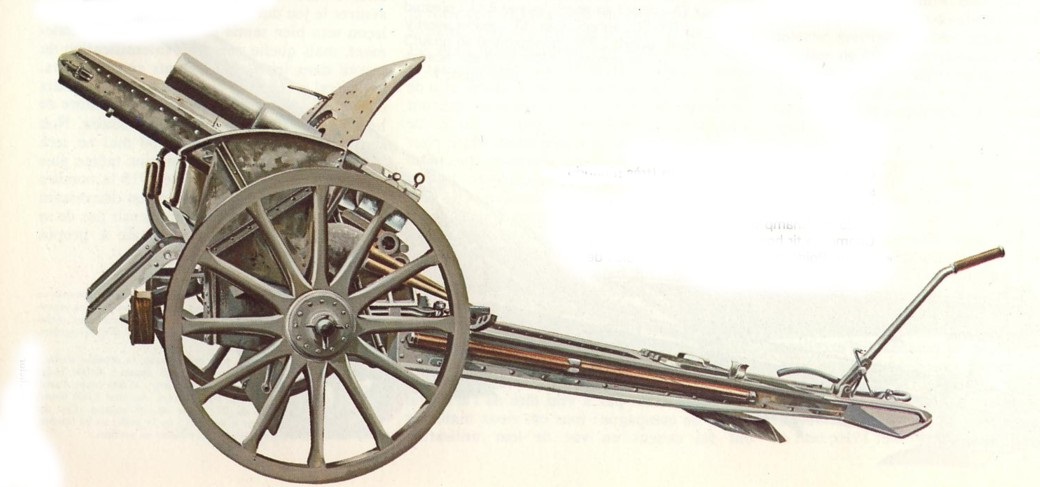
Carriage Design
The lFH 98/09 was mounted on a box trail with a space between the side arms to accommodate the recoil of the gun. It was fitted with wooden spoked wheels 1.66 m (5′ 5.5″) in diameter fitted with steel tyres 70 mm wide.  A 4 mm thick gun shield was mounted on the trail with the lower part hinged for stowage during transport. A spade was provided at the rear of the trail to stabilise the gun during firing working with brake shoes at the front of each wheel. The gun was normally towed behind a two-wheel limber pulled by 6 horses which carried 24 complete rounds in 3-round baskets. Three gunners were seated on the limber during towing and two more were seated in front of the gun shield on the seats provided.
A 4 mm thick gun shield was mounted on the trail with the lower part hinged for stowage during transport. A spade was provided at the rear of the trail to stabilise the gun during firing working with brake shoes at the front of each wheel. The gun was normally towed behind a two-wheel limber pulled by 6 horses which carried 24 complete rounds in 3-round baskets. Three gunners were seated on the limber during towing and two more were seated in front of the gun shield on the seats provided.
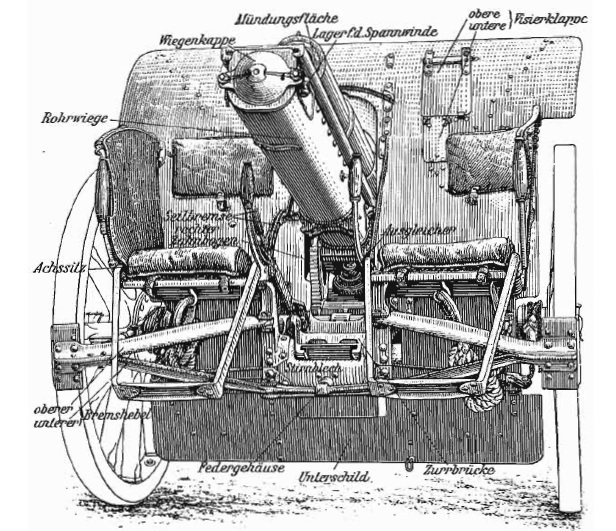
In contrast with the Fk 96 n.A where the gun cradle pivoted on a gimbal mounted on the wheel axle, the cradle on the lFH 98/09 was equipped with trunnions at the rear that pivoted on a saddle with triangular side plates. The saddle was mounted on a bearing at the front on the box trail and provided ± 2°of traverse via a hand wheel. The cradle was fitted with a pair of toothed elevating arcs underneath that engaged with gears at the front of the saddle connected to the elevating hand wheel. Since the trunnions were at the rear of the cradle, the weight of the gun had to be balanced by a telescopic spring strut mounted between the elevating arcs supported at the lower end on the trail and fitting into a socket at the top under the cradle.
The cradle was fitted with a horizontal bar (Abweiser) to keep the left-hand gunner clear of the breech when the weapon was fired. Just in front of this bar was a lever ( Zurrhebel) that rotated a clamping bracket under the front of the shield to clamp the lowered gun during transport.
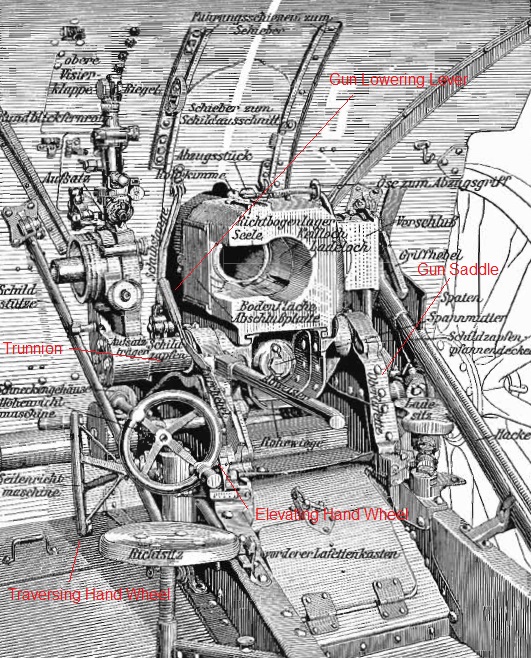
Gun Design
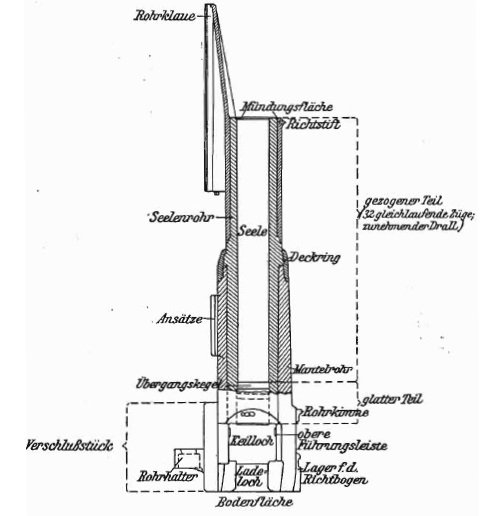
The gun was 1.625 m or 15.5 calibres long with the rifled part of the barrel being 11.0 calibres or 1.15 m in length. The gun was of built up construction with the jacket shrunk on to it and extending for about half of the length of the barrel being securing at the front by a threaded locking ring. A guide tray was attached to the gun to allow it to slide along runners on either side of the top of the cradle during recoil. The front of the tray extended some distance in front of the gun and was attached via a tube shrunk on to the gun. The rear of the guide tray was attached to projections underneath the jacket and breech.
The jacket was shaped at the rear to support a horizontal sliding breech block of Krupp design. The breech was opened using a single motion lever on the right of the breech which moved the breech block to the right exposing the breech and ejecting any cartridge in the chamber. The breech incorporated an axial striker to fire a loaded projectile which was cocked and released in a single motion using a lanyard on the right of the breech.
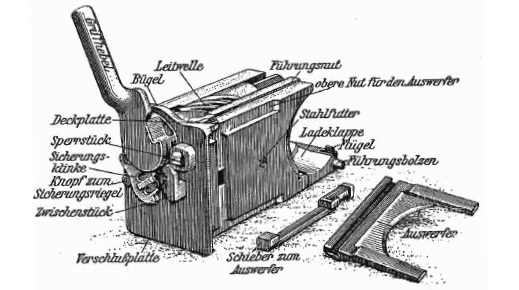
Recoil System
The lFH 98/09 used a relatively simple hydro-spring recoil system mounted within the cradle. This consisted of a hydraulic buffer using a cylinder filled with oil connected to a lug under the breech and therefore recoiled with the gun. The piston within the hydraulic cylinder was mounted on the end of a rod fixed to the front cap of the cradle. The piston incorporated ports that restricted the flow of oil past it during recoil absorbing the recoil energy and bringing the gun to a stop after firing. The maximum recoil length was 1.03 m (40 in).

A recuperator spring was fitted over the hydraulic cylinder with a flange on the front end such that, when the gun recoiled, the spring was compressed between the flange and rear of the cradle running out the gun fully once the recoil had ended.
Unlike the equivalent British light Ordnance QF 4.5-Inch Howitzer, the lFH 98/09 did not use a cut-off gear to reduce the length of the recoil as the gun was elevated. In the case of the British gun, this had to be done to stop the breech hitting the ground at high elevation angles. However, in the case of the lFH 98/09, this was not necessary because the gun pivoted on rear mounted trunnions maintaining sufficient clearance from the ground at all times.
Sights
The sights on the lFH 98/09 were fixed to the end of the left-hand trunnion and therefore elevated with the gun. These sights were said to be reciprocating in order to overcome the problem caused when the carriage wheels were not level which was the norm. This led to a tilt of the gun trunnions which then caused the vertical plane containing the shell trajectory to rotate in azimuth relative to the centre line of the carriage in the direction of the lower trunnion made worse by the high angle trajectories used by howitzers. To overcome this problem, the sights had to be tilted back into the vertical plane using the lower left-hand knob which aligned them with the same plane as the projectiles. A cross-bubble (Radstandlibelle) was provided to facilitate the alignment.
The sights were fitted with a collimator (Richtglas) for direct fire and a dial sight (Rundblickfernrohr) for indirect fire. These were both provided with an adjustment and dial (Teilschreiber) to allow deflection to be added to the sight, in particular, to account for the spin drift of the projectiles. The sighting devices were mounted on top of a toothed sight arc that was raised or lowered using either the course adjustment knob (Schnelltrieb) on the left-hand side of the sight body or by using the fine control knob at the back (Schneckentrieb). Raising the sight arc tipped the sights forward imposing a negative elevation to them.
The sight body was provided with a range drum (Trommel) linked to the sight arc and indicated the range for each of the different charges used with the gun. An adjustable pointer (Zeiger) was used to select the appropriate scale. The sight arc also mounted an adjustable clinometer (Winklemesser) to allow the elevation of the gun to be set. To do this, the angle of sight was first set on the clinometer (angle of the target above the horizontal through the sights) and the range then set on the range drum. By elevating the gun until the clinometer bubble was level then achieved the required quadrant elevation (elevation of gun above the horizontal plane).

Rather than using a conventional telescope as the direct fire aiming device, the lFH 98/09 used a collimating sight. This type of sight consisted of a rectangular hood through which the target was viewed together with a small collimator in the lower part. The collimator generated a cross-hair reticule in the field of view of the sight effectively focused at infinity. Therefore, what the gun layer saw when looking through the sight hood was the target with the reticule superimposed on it with very little parallax. In use, the gun layer positioned his head about 10 inches behind the sight to use it properly.
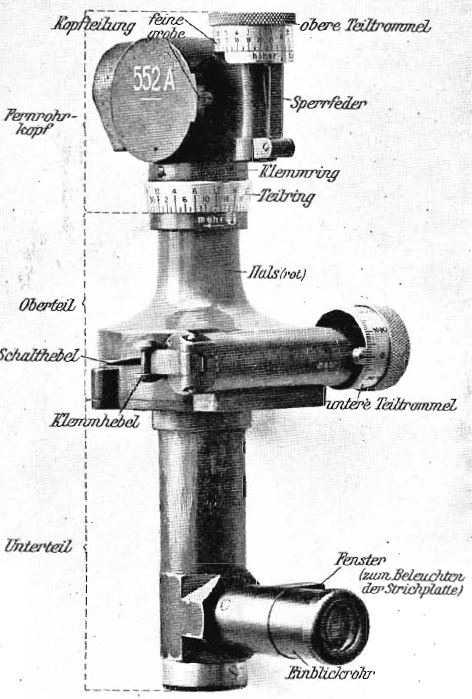
Indirect fire was carried out using what the British termed a dial sight and the Germans called a Rundblickfernrohr. The original version of this type of sight was invented in 1906 by a German called Goertz and took the form of a panoramic telescope with an adjustable sighting head that could be rotated from 0 – 360 degrees or 0 – 6400 MILs. The eyepiece was fixed and aligned with the axis of the gun. The sighting head was equipped with an azimuth scale graduated in 100’s of MILs and was normally adjusted using a micrometer knob graduated in 10’s of MILs. The sight was also fitted with another micrometer at the top to allow adjustment of the angle of sight.
During indirect fire, the range, angle of sight and bearing were worked out by a plotting officer using a map showing both the target and gun positions. The target bearing was defined relative to an aiming point defined for the gun which could be a prominent feature in the landscape or could be aiming posts specially set up for this purpose. To aim the gun in the target direction required the relative bearing to be set up on the panoramic dial sight and then the gun traversed until the aiming point was centred in the sight which pointed the gun at the target.
Ammunition
The lFH 98/09 fired 4 different types of shell and used a separate cartridge case providing 7 different charges.
Cartridge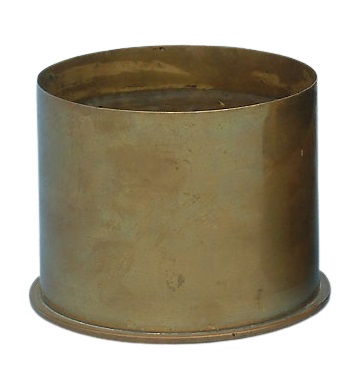
The short brass cartridge could be loaded with 7 separate charges to produce a range of muzzle velocities from a minimum of approximately 150 m/s to a maximum of 302 m/s. The shell was fired using a percussion primer in the end of the cartridge case.
F.H. (Feldhaubitze) Geschoss 05 – Universal Shell
 This universal shell was introduced in 1905 and was intended to be used either as a high explosive (HE) or a Shrapnel shell. It was filled with 400 lead balls surrounded by Amatol explosive. The nose was also filled with a small amount of TNT. It was fitted with a H.Z. 05 time and percussion fuze. This allowed the shell be detonated by percussion as a HE shell either with instantaneous or delayed action. The time delay function allowed the shell to be detonated above the ground as a Shrapnel shell. However, this type of shell was rendered obsolete by about 1916. The shell was 347 mm long without the fuze and weighed 15.7 kg.
This universal shell was introduced in 1905 and was intended to be used either as a high explosive (HE) or a Shrapnel shell. It was filled with 400 lead balls surrounded by Amatol explosive. The nose was also filled with a small amount of TNT. It was fitted with a H.Z. 05 time and percussion fuze. This allowed the shell be detonated by percussion as a HE shell either with instantaneous or delayed action. The time delay function allowed the shell to be detonated above the ground as a Shrapnel shell. However, this type of shell was rendered obsolete by about 1916. The shell was 347 mm long without the fuze and weighed 15.7 kg.
H.Gr (Haubitze Granade) 14-HE Shell
This shell was fabricated out of cast iron to make it easier to manufacture by private firms but did not prove satisfactory and was replaced in the following year. It was filled with Amatol and fitted with a percussion H.Z 14 Fb or E.H.Z 17 fuze. It was 298 mm long without the fuze and weighed 15.5 kg.
H.Gr (Haubitze Granade) 15-HE Shell
This shell was produced in 1915 to replace the earlier HE shell and was made from cast steel and filled with Amatol. It was fitted with either the H.Z 05 Gr percussion and time fuze or the H.Z. 16 or E.H.Z 17 percussion fuzes. It was 346 mm long without the fuze and weighed 15.7 kg.
L.F.H. Gr (Lange Feldhaubitze Granade) – HE Shell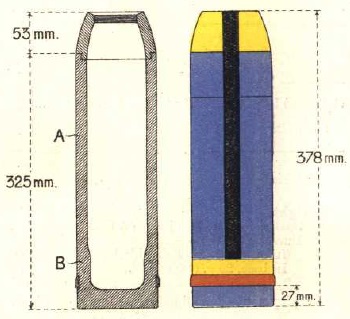
This was the long pattern shell fitted with either the H.Z. 05 Gr time and percussion fuze or the H.Z 16 percussion fuze. With non-delay percussion fuze, the shell was used to attack living targets either in the open or concealed. The delayed action percussion fuze was used to attack trenches, machine gun posts and also buildings. It was also used when the shell was fired to ricochet off the ground when conditions permitted. The time fuze was used for air burst to attack targets behind shelter or in the open. The shell was 378 mm long without the fuze and weighed 15.6 kg.
L.F.K.Gr (Lange Feldkanone Granade) – Gas Shell
There were at least 3 types of gas shell used: L.F.K.Gr Grkz (Green Cross long pattern), L.F.K.Gr Blaukreuz (Blue Cross long pattern) and L.F.K.Gr Gelbkreuz (Yellow Cross long pattern). The gas shells used with the lFH 98/09 were developed using the long HE shell and were similar to those developed for the FK 96 n.A. They were filled with the toxic chemicals which was released when the bursting charge was set off. The shells were fitted with a range of fuzes including K.Z.14, E.K.Z. 17, E.K.Z. 16.
The green cross shells contained chlorine, phosgene or diphosgene which were designed to cause breathing problems. The blue cross shells contained diphenylchlorarsine (DA) in a bottle that was surrounded by TNT. When the shell exploded, the DA was reduced to a fine powder which caused vomiting when inhaled. The yellow cross shells contained the liquid dichlorodiethyl sulphide which when released to the atmosphere produced a blistering gas which the British called Mustard Gas because of the smell it produced.
F.H (Feldhaubitze) Leuchtgeschoss L/3.3 – Star Shell
The shell was used to illuminate battlefield targets at night and was fitted with a Lg. Zdr S/22 time fuze. When the time fuze detonated, the flash set off the charge in the head of the shell blowing it off. The flash also passed down the central tube setting off the bursting charge in the base, ejecting the flare from the shell and also igniting the flare composition. A parachute was attached to the flare producing a slow descent. The shell was 350 mm long without the fuze and weighed 12.5 kg.
10.5 cm leichte Feldhaubitze 98/09 Specifications
- Length: 4.1 m
- Maximum Width: 1.53 m
- Wheels: Wooden 1.36 m in diameter
- Weight of Gun & Carriage: 1225 kg
- Length of Gun: 1.625 m or 15.5 calibres
- Bore: 10.5 cm
- Weight of Gun & Breech: 335 kg
- Muzzle Velocity: 302 m/s
- Maximum Range: 6,300 m
- Trail: Box trail
- Recoil System: Hydro-spring
- Maximum Recoil: 1.03 m
- Rifling: Polygroove with modified plain section
- Length of Rifling: 11.0 calibres (1.15 m)
- Twist: unknown
- Grooves: 32
- Firing Method: Percussion
- Elevation: -13° to +40°
- Traverse: -2° left to +2° right
![]()

